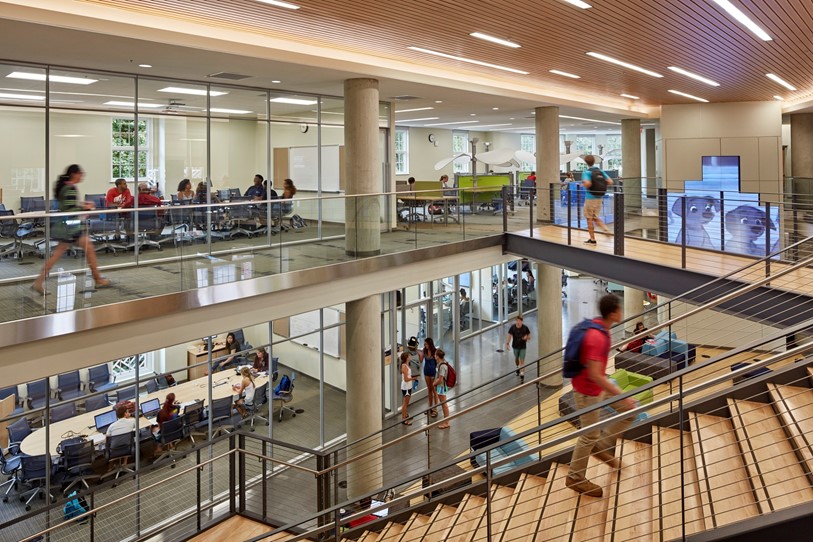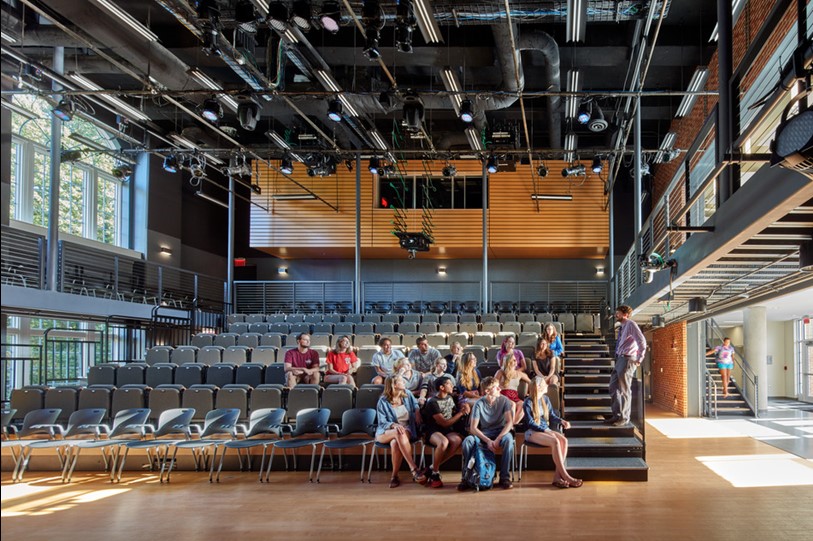Teaching the Teachers
Helping faculty master digital technology teaching tools
Technology is moving ever more into education as students use mobile devices, laptops and online content as daily tools.
But while today’s students are quite comfortable infusing technology into almost everything they do, that’s not always the case for faculty. Many embrace technology in their pedagogy, but those less familiar are unlikely to confidently embrace tools that are new and for some, intimidating. Having high tech classrooms and tools is effective only if the faculty know how to use them — and are comfortable doing so.
The University of Mary Washington considered this reality more than six years ago as it envisioned what became the Hurley Convergence Center, a one-of-a-kind building at UMW, where a variety of technology, information and teaching resources come together.
The center includes wired and wireless network access, a digital knowledge center where students tutor other students on digital projects, a mix of classrooms, including active learning ones, seminar rooms, team collaboration studios, a multimedia lab and a 200-seat digital auditorium for lectures and training. Other features include a café, digital media production facilities, multi-media presentation spaces and multi-function collaboration rooms. Most of these spaces, faced with glass walls, put the activities within on display and allow the users to remain connected through the multi-story atrium to the energy surrounding them. Interactive technology on full display.
The center was envisioned as a 21st Century manifestation of readily accessible information, student-staff engagement and student collaboration and innovation.

Helping faculty explore
It was also expanded to create a non-threatening staff training center to help faculty explore, train, and master the tools that will help them teach technologically savvy millennials more effectively.
Jeffrey McClurken, University of Mary Washington professor and Special Assistant to the Provost for Teaching, Technology, and Innovation, says that not all of the school’s 200 faculty have re-engineered teaching styles to accommodate more technology, "and not all should."
But now that the center has been open for three years, more of them are coming to the center to ask how technology might accentuate their teaching efforts, and they’re learning from other faculty and early adopters who have already folded technology into the classroom.
One biology instructor, for example, started booking the active learning classroom on Fridays so that students could more easily work in small groups at tables, and then share their research that day with their classmates. In the regular classroom, small group work was limited by the room set up and inflexible furniture, leaving groups to often spill out into the hallway.
Almost all of the faculty have also set up their own domains and more of them are using the tech support help that workers at the center offer.
“We’re constantly balancing giving early adopters (faculty) the support they need and reaching out to others,” McClurken says.

Learning Together
A high level of commitment was required to create a setting that offered the most effective teaching-learning tools. More than a quarter of the construction budget went to building and equipment technology, including flexible furniture such as tables and chairs that can used in a seminar setting one day and a small group environment the next.
The center’s Division of Teaching and Learning Technologies offers training in a variety of spaces that allow students, faculty, and staff to interact on both curricular and extracurricular projects, reducing the anxiety associated with tech-intimidation. Self-service workstations and spaces are outfitted with computer, video production, and other technologies to help users transition to the latest tools and approaches.
The investment has clearly been worth it as evidenced by the building’s use. "It is packed, with students after four in the afternoon, as they gather to study and hang out, in groups or alone," McClurken says. Earlier in the day, students and faculty are coming and going given use of the various classrooms and spaces.
The center is also a place for the University of Mary Washington to further discussions on digital technology in teaching. A recent week-long conference on “Digital Pedagogy Lab” attracted 100 participants from around the world, including 20 faculty and staff from the University of Mary Washington.
The center “is being used by everybody as we hoped it would be,” says Jerry Slezak, the University’s Director of IT Support Services. Technology for UMW students, staff, and faculty, it turns out, is both useful and well used.
